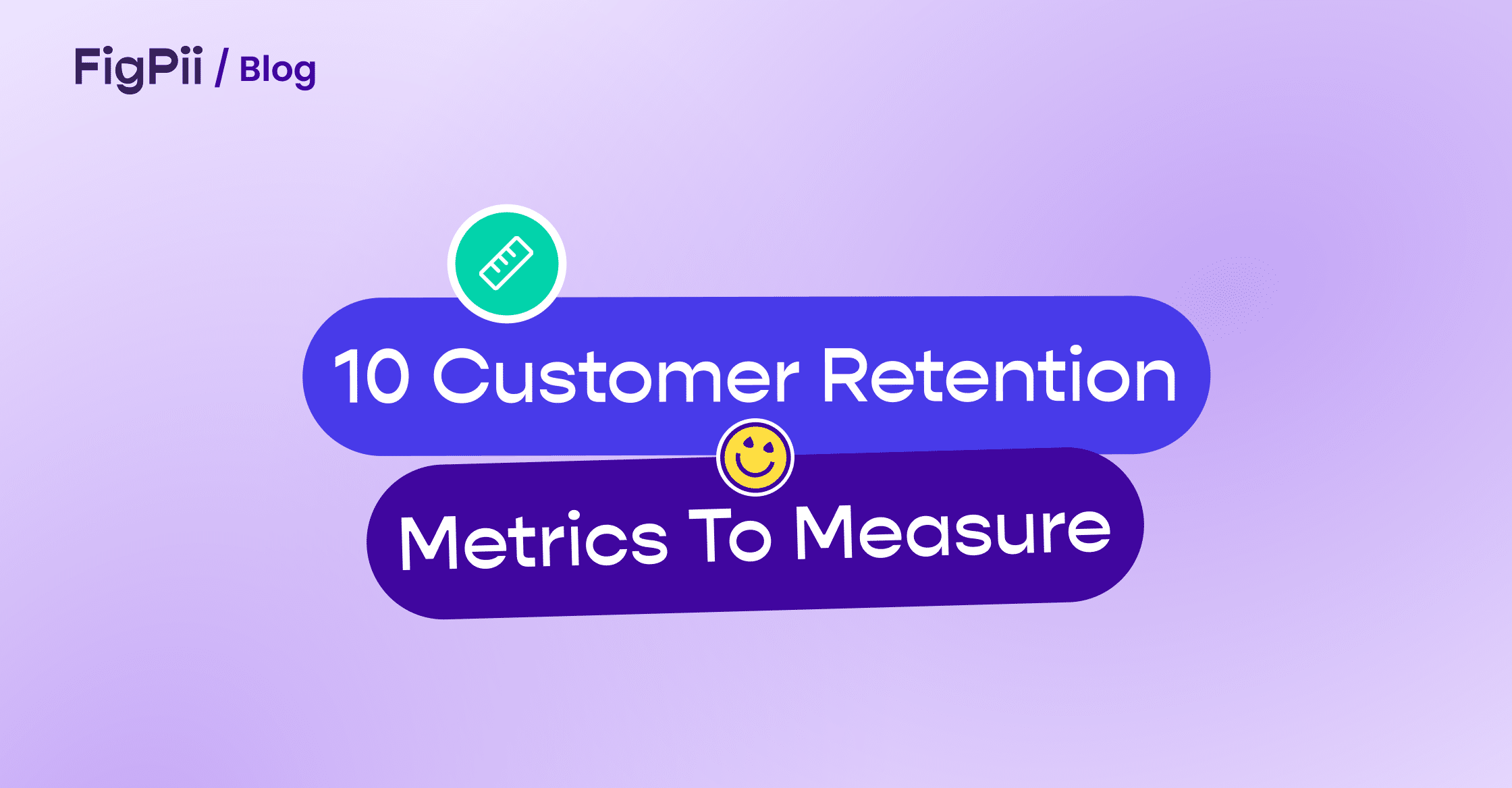Let’s face it; customer retention is like the gym membership we keep renewing but never use. If you’re like me, that is. But just like how we justify our gym memberships with the hope of getting fit someday, businesses justify their retention efforts to retain customers.
Well, hope is not a strategy, but metrics are. So, if you want to turn your retention efforts into tangible results, this article discusses different customer retention metrics you should measure.
What are Customer Retention Metrics?
Customer retention metrics are measurable indicators used to evaluate how well a business maintains its existing customer base over a specific period.
These metrics focus on understanding customer loyalty, satisfaction, and long-term engagement, helping businesses assess the success of their retention efforts.
By tracking customer retention metrics, companies can identify patterns in customer behavior, detect areas where churn might occur, and refine their strategies to nurture stronger, lasting relationships with customers.
Retention metrics provide businesses with a clearer picture of their ability to deliver value consistently and meet customer expectations.
Unlike metrics focused solely on acquisition, retention metrics emphasize the importance of maximizing the lifetime value of existing customers, which often leads to higher profitability and sustainable growth.
Why Customer Retention Is Important
Customer retention is the ability of a business to keep its existing customers over time by providing high-quality products and services, exceptional customer service, and engaging experiences.
It involves developing ongoing relationships with your customers, maintaining open lines of communication, implementing customer feedback, and continuously improving the quality of products and services.
- Cost-Effectiveness: Acquiring new customers can be expensive, but retaining existing customers is much more cost-effective since you can leverage your existing relationships and ongoing engagement to keep customers satisfied and loyal.
- Customer Lifetime Value (CLV): Customer retention metrics such as CLV help you see the long-term value of your customers.
- Churn Reduction: You can also develop targeted retention strategies to reduce churn and keep customers engaged by measuring churn rate and identifying the reasons for churn. This can lead to increased revenue, improved customer satisfaction, and long-term success.
- Competitive Advantage: You can gain a competitive advantage over your rivals by developing effective customer retention strategies and measuring customer retention metrics.
- Customer Satisfaction: Customer retention metrics such as customer satisfaction scores help businesses understand how well they meet customer needs and expectations.
How to Measure Customer Retention
-
Define Your Retention Period
When we talk about measuring customer retention, it’s important to determine the time frame you want to focus on.
Think about how long you want to track and evaluate customer retention. It could be a month, a quarter, a year, or any other period that makes sense for your business.
This will give you a specific window to measure how well you’re retaining customers.
-
Identify Key Customer Retention Metrics
Once you have the data, it’s time to identify the key metrics that will help you understand customer retention.
These metrics can vary depending on your business, but common ones include customer churn and retention rates.
These metrics give you a quantifiable way to evaluate your customer retention efforts.
-
Gather Customer Data
To effectively measure customer retention, you need to gather relevant data about your customers. This includes information like their names, contact details, purchase history, and interactions with your brand. ‘
By collecting this data, you’ll have a clearer picture of how your customers are engaging with your business over time.
-
Determine Your Customer Retention Benchmark
To gauge how well you’re doing in terms of customer retention, it’s helpful to establish a benchmark. This benchmark could be an industry standard, your own historical data, or a specific target you want to achieve.
Having a benchmark allows you to compare your performance over time and see if you’re making progress or need to make adjustments to your strategies.
-
Identify Opportunities for Improvement
Measuring customer retention isn’t just about tracking numbers; it’s about finding opportunities for improvement.
Analyze the data and identify patterns or trends that indicate areas where you could enhance your retention efforts.
For example, noticing a significant drop in retention among a certain customer segment could signal the need for targeted retention initiatives for that group.
-
Monitor Customer Retention Over Time
Customer retention is not a one-time measurement; it’s an ongoing process. Continuously monitor and track your customer retention metrics over time.
This will help you understand if your efforts are having a positive impact and if you’re consistently meeting your retention goals.
Regular monitoring allows you to make timely adjustments and improvements to your customer retention strategies.
Important Customer Retention Metrics To Track
Customer retention metrics are the key performance indicators that measure how well a business retains customers.
These metrics are essential for businesses and marketers to track as they give insights into their retention strategies’ effectiveness and capacity to establish lasting customer relationships.
Let’s get into the details of some important customer retention metrics to track
-
Customer Lifetime Value (CLV)
Customer Lifetime Value (CLV) is the estimated amount of money a customer will spend on a product or service over the entire duration of their relationship with your business.
A helpful way to understand CLV is to think of a customer as a plant that needs to be nurtured to grow and bear fruit. The longer the plant is cared for and the more fruit it produces, the more valuable it becomes.
Why CLV is an essential metric for customer retention
Here are some reasons why we think Customer lifetime value is an important customer retention metric to track
- CLV helps you identify your profitable customers: By calculating CLV, businesses can identify which customers generate the most revenue and focus their retention efforts on those customers.
- CLV helps businesses make strategic decisions: CLV can be used to set marketing budgets, pricing strategies, or product development priorities.
- CLV helps businesses understand the impact of churn on high-value customers: By understanding the CLV of a customer, businesses can estimate the financial impact of churn. If a high-value customer churns, it can significantly impact the business’s revenue.
How to calculate customer lifetime value
CLV can be calculated using the following formula:
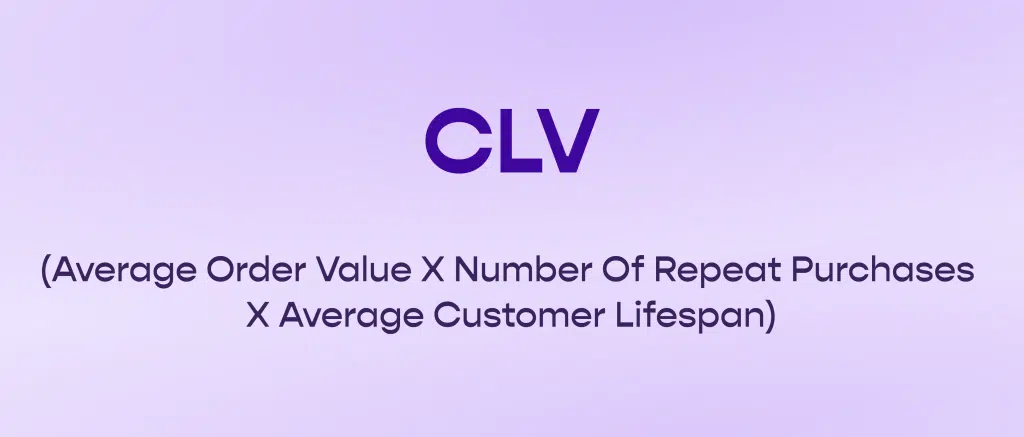
As mentioned, tracking and calculating metrics is not useless if no insights are obtained from the results. After calculating your customer lifetime value, here are some factors to consider to make sense of the results:
- High or low value: CLV results can be either high or low, depending on the value of your customers to your business. High CLV values indicate that your customers are generating significant revenue for your business over their lifetime, while low CLV values suggest that your customers are not as valuable.
- Average CLV: Calculating the average CLV for your customer base can provide a benchmark for comparing the value of different customer segments or cohorts.
- Customer segments: Analyzing CLV results by customer segment can provide insights into which types of customers are most valuable to your business.
- Customer acquisition costs: If your CLV is lower than your customer acquisition costs, you may need to adjust your marketing and sales strategies to improve customer retention and maximize the value of your existing customer base.
How to Improve Customer Lifetime Value
CLV is an essential aspect of your business, and here are some ways to improve your CLV
- Provide excellent customer service: Providing excellent customer service can improve customer satisfaction, leading to higher CLV. Responding to customer inquiries quickly, resolving issues promptly, and providing personalized support can help build strong relationships with customers and encourage them to remain loyal to your brand.
- Personalize the customer experience: Personalizing the customer experience can help increase customer engagement and loyalty and improve CLV.
- Offer loyalty rewards and incentives: Offering loyalty rewards and incentives, such as discounts, exclusive offers, and points-based rewards programs, can encourage customers to make repeat purchases and increase their overall spending with your business.
- Upsell and cross-sell additional products and services: Upselling and cross-selling additional products and services to existing customers can increase the overall value of their purchases and boost their CLV. This can be achieved through targeted marketing campaigns and personalized product recommendations.
- Focus on customer retention: Retaining existing customers is often more cost-effective than acquiring new ones. Focusing on customer retention and reducing customer churn makes increasing CLV and financial performance easier.
-
Repeat Purchase Rate
Repeat purchase rate is a metric that measures the percentage of customers who make a repeat purchase from a company within a specified period.
Imagine you are a restaurant owner and want to know how many regular customers return to your restaurant for a second or third meal. Repeat purchase rate is the percentage of customers who become regulars and return to your restaurant repeatedly.
Why repeat purchase rate is an important metric.
- It indicates customer loyalty: A high repeat purchase rate suggests that customers are satisfied with the product or service and willing to return and make a repeat purchase. This indicates that the business has built a loyal customer base, vital for long-term growth.
- It’s more cost-effective: Acquiring new customers is generally more expensive than retaining existing ones. You can generate more revenue from existing customers by tracking and increasing repeat purchase rates, which can be more cost-effective in the long run.
- It’s an important factor in customer lifetime value (CLV): Repeat purchase rate is one of the key factors contributing to CLV. If you can improve your repeat purchase, then it automatically increases CLV and revenue.
- It can help identify areas for improvement: By tracking repeat purchase rates, businesses can identify areas where they need to improve, such as product quality, customer service, or pricing. This can help businesses make strategic improvements that increase customer loyalty and retention.
How to calculate Repeat Purchase Rate
The formula for calculating the repeat purchase rate is as follows:
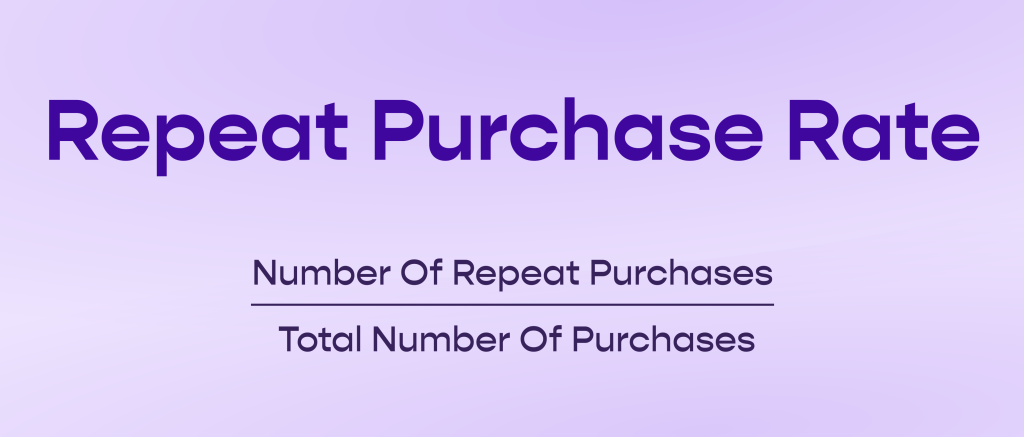
When calculating your business’s repeat purchase rate, here are a few things to remember:
- Determine the period: First, determine the period the repeat purchase rate represents, such as a month, quarter, or year.
- Analyze trends over time: Track your repeat purchase rate to see if it’s improving, declining, or staying the same. This can help you identify changes in customer behavior and make strategic decisions.
- Identify areas for improvement: If your repeat purchase rate is lower than expected, identify potential reasons, such as poor product quality or inadequate customer service. This can help you make strategic improvements to increase customer loyalty and retention.
- Use the data to inform decision-making: Use the insights gained from analyzing your repeat purchase rate to inform decision-making and develop strategies for improving customer retention and increasing revenue.
-
Churn Rate
Churn rate is a metric used to measure the rate at which customers stop doing business with a company or using its products or services over a given period. It is also sometimes referred to as customer attrition or turnover rates.
In other words, churn rate is the percentage of customers who have stopped using a company’s product or service over a certain period.
The churn rate is typically calculated as the number of customers lost during a specific time divided by the total number of customers at the beginning of that period.
For example, if a company had 1000 customers at the beginning of a month and lost 100, its churn rate would be 10% (100/1000).
Why is Churn Rate an important metric for retention?
Churn rate is an important customer retention metric because it helps you evaluate how quickly or slowly your business is losing customers. This puts you in a position where you must double up and understand why that is happening.
If you are still wondering why churn rate is an important metric to track, here are some valid reasons
- Indicates product or service quality: A high churn rate can indicate that customers are dissatisfied with your product, leading to decreased loyalty and engagement. Tracking churn rate can help you identify the problems and make necessary adjustments.
- Helps to understand customer behavior: Businesses can gain insights into customer behavior and preferences by tracking churn rates.
- Enables proactive retention strategies: Businesses can take proactive measures to retain customers by tracking churn rates.
- Provides a metric for measuring retention efforts: Churn rate can be used as a benchmark to measure the effectiveness of retention efforts.
Calculating Churn Rate and Interpreting Results
Churn Rate formula is as follows:
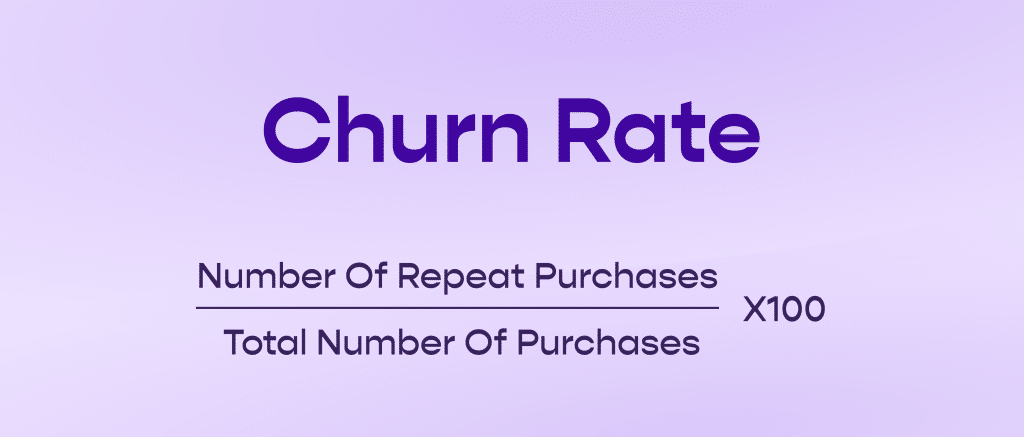
Calculating your churn rate is not enough; it’s also important that you can make sense of the information it reveals. Here are some key considerations when interpreting churn rate results:
- Benchmark against industry standards: Churn rate varies by industry, so it is important to benchmark against the industry standards your business belongs to.
- Look for trends: It is important to look at churn rate trends over time. If the churn rate is consistently high or increasing, it suggests that you need to take action to improve retention efforts.
- Identify the source of churn: Understanding why customers are churning and also identifying the sources can help you target retention efforts more effectively.
- Analyze customer segments: Churn rate can vary by customer segment, so it is essential to analyze churn rate by different segments such as demographics, usage patterns, or customer behavior.
- Determine the impact on revenue: Churn rate directly impacts revenue, so it is vital to calculate the revenue lost due to churn to understand the financial impact of churn.
-
Net Promoter Score (NPS)
Net Promoter Score (NPS) is another customer retention and satisfaction metric measuring the likelihood of customers recommending your business to others. It is usually measured on a scale of 0-10, with customers being categorized into three groups: detractors, passives, and promoters.
Think of NPS as a fishing net. Just as a fishing net captures fish, a company’s NPS captures the sentiment of its customers. The net is made up of three sections that correspond to the three categories of customers – detractors, passives, and promoters.
- The detractors are the fish that swim away from the net because they had a negative experience with the company’s product or service.
- The passives are the fish caught in the net but are not strong enough to influence other fish to join them.
- The promoters are the fish caught in the net and bring other fish.
Why Net Promoter Score is Important
- Helps identify customer satisfaction: NPS provides insight into how satisfied customers are with a business, which is essential for customer retention.
- Prediction of customer loyalty: Studies have shown that customers willing to recommend a business to others are more likely to be loyal and continue doing business with the company.
- Provides valuable feedback: The feedback obtained through NPS surveys can help businesses identify areas for improvement and make changes that increase customer satisfaction and retention.
- Can lead to increased revenue: You can generate more revenue from repeat purchases and referrals by improving NPS scores and increasing customer loyalty.
Calculating Net Promoter Score and interpreting results
To calculate NPS, customers are asked to rate on a scale of 0-10 how likely they are to recommend a business to a friend or colleague.
Customers are classified into three categories based on responses:
- Promoters (score 9-10)
- Passives (score 7-8)
- and Detractors (score 0-6)
The NPS is then calculated by subtracting the Detractors’ percentage from the Promoters’.
The formula for calculating NPS is
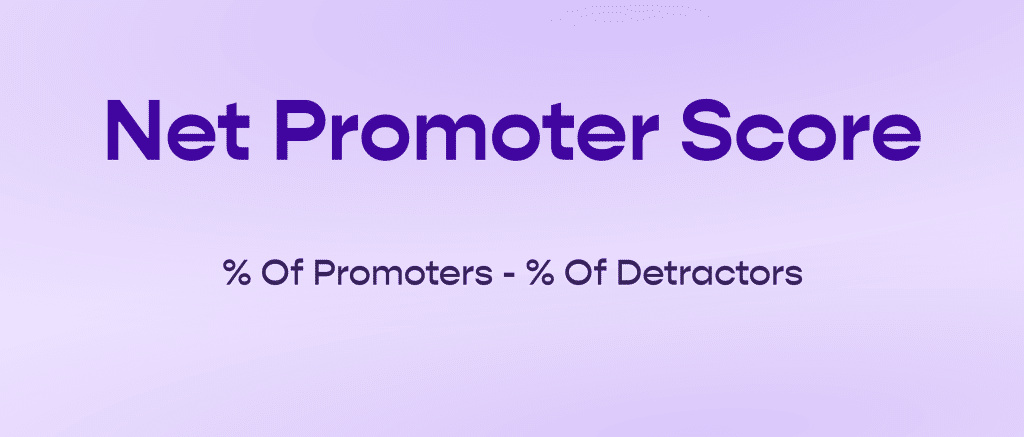
How To Improve Net Promoter Score
You can adopt many strategies to boost your NPS; Here are five ideas to consider if you want your promoters to outnumber your detractors significantly.
- Improve the customer experience: Customers are more likely to recommend a business if they have a positive experience.
- Communicate effectively: Clear and timely communication can go a long way in building trust and loyalty. Businesses can communicate proactively about product updates, promotions, and other relevant information to keep customers informed and engaged.
- Offer incentives: Providing incentives to customers who recommend the business to others can encourage them to share their positive experiences.
- Address customer feedback: Listening to customer feedback and addressing concerns can help build trust and improve satisfaction.
- Leverage social media: Social media platforms offer an excellent opportunity for businesses to connect with customers, build relationships, and gather feedback. Businesses can engage with customers on social media, respond to comments and feedback, and use social listening tools to monitor brand mentions and sentiment.
-
Customer Satisfaction (CSAT) Score
When I think about customer satisfaction, the first thing that comes to mind is restaurants. Those guys are at the mercy of their customers. One bad review from a disgruntled customer can negatively impact their business.
Customer satisfaction score (CSAT) is a metric that measures the level of satisfaction customers have with a product, service, or experience. It is typically measured through a survey that asks customers to rate their satisfaction on a scale.
Importance of Customer Satisfaction Score as a Retention Metric
- Helps identify areas for improvement: CSAT surveys provide valuable feedback that you can use to improve your product, service, or user experience.
- Increases customer loyalty: Customers who are satisfied with a company’s product, service, or experience are likelier to remain loyal and continue doing business with that company.
- Provides insights into customer needs and preferences: You can gain insights into customers’ needs and preferences by asking customers about their satisfaction levels.
- Helps measure business success: CSAT provides a tangible way to measure the success of your efforts to improve customer satisfaction.
- Tracking CSAT and using its insights to improve customer experience provides a competitive advantage.
How to Calculate Customer Satisfaction Score
The formula for calculating CSAT is as follows:
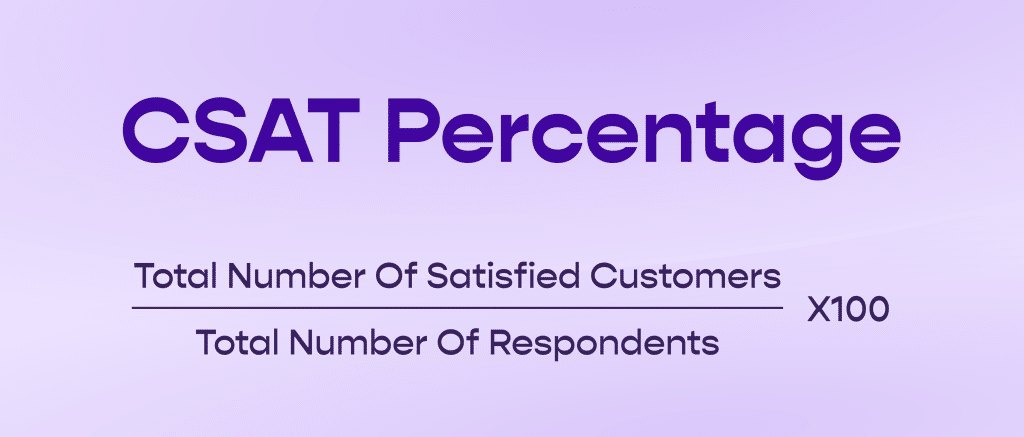
3 Important things to note when analyzing customer satisfaction score:
- Understand the scale: CSAT scores are typically measured on a scale of 0 to 100, with higher scores indicating higher levels of customer satisfaction. Understanding the scale used and what constitutes a good or bad score for your industry is necessary.
- Analyze the score: Look at the CSAT score to determine whether it is high or low. A high score indicates that customers are satisfied with the product, service, or experience, while a low score indicates room for improvement.
- Review the feedback: CSAT alone cannot give you a complete picture of customer satisfaction. Read through the comments and feedback provided by customers to understand why they rated the product, service, or experience the way they did. Look for common themes or issues that can be addressed to improve customer satisfaction.
How to improve CSAT and increase conversion rate
There is some overlap between the strategies for improving Net Promoter Score (NPS) and Customer Satisfaction (CSAT) because both metrics are closely related to the customer experience. However, while the former focuses on customer loyalty, the latter focuses on customer satisfaction.
If you want to keep your business moving forward, keeping your customers happy and satisfied should be a priority; here are some things you can do to improve your CSAT.
- Improve response times: Customers appreciate timely responses to their inquiries, complaints, or feedback. Ensuring a quick response time to customer queries can improve CSAT.
- Offer personalized solutions: Customers prefer personalized solutions to generic ones. Providing personalized solutions based on their preferences, past purchases, or interactions can enhance the customer experience and increase CSAT.
- Simplify processes: Customers find it frustrating when processes are complicated, time-consuming, or require too many steps. Simplifying processes, such as the checkout process, returns policy, or complaint handling, can make it easier for customers to interact with your business.
- Gather and act on feedback: Actively seeking and acting on customer feedback gathered through surveys, reviews, or customer service interactions can enhance customer satisfaction.
-
Referral Rate
Referral rate is a metric that measures the percentage of customers who refer your business to others. A business with a high referral rate can create a network of satisfied customers who refer others to the business. Each referral creates a ripple effect, as the referred customer may refer others, leading to a chain reaction of new customers.
Why Referral Rate is Important
- Cost-effective marketing: Referral marketing is a cost-effective way to acquire new customers. Referral customers are more likely to purchase and have a higher lifetime value.
- Increased customer loyalty: Customers who refer others are usually delighted with your product or service, which increases their loyalty and reduces churn rate.
- Trust and credibility: Referral customers are more likely to trust your business, as the recommendation comes from someone they know and trust.
- Brand awareness: Referrals can help increase brand awareness and exposure as new customers are introduced to your business.
How to Calculate Referral Rate
If you run a referral campaign for a product, you calculate your referral rate using this formula.
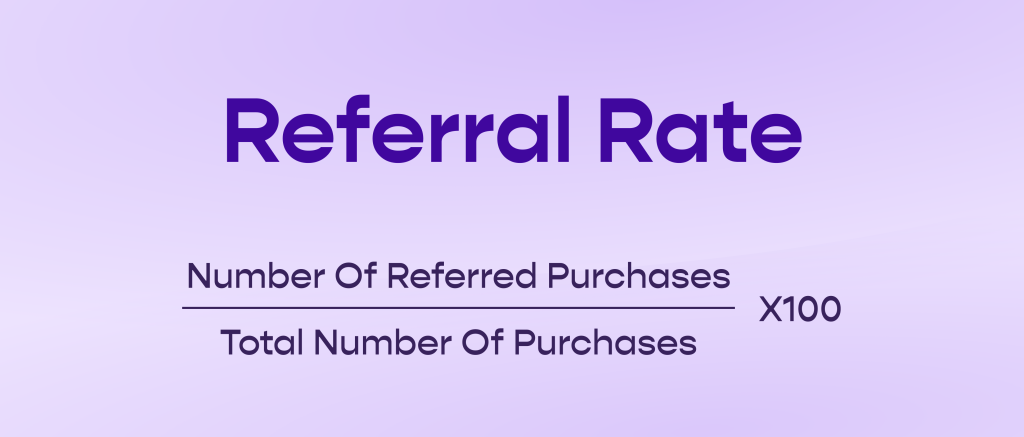
On the other hand, if you want to calculate the referral rate for new customers, use this formula.
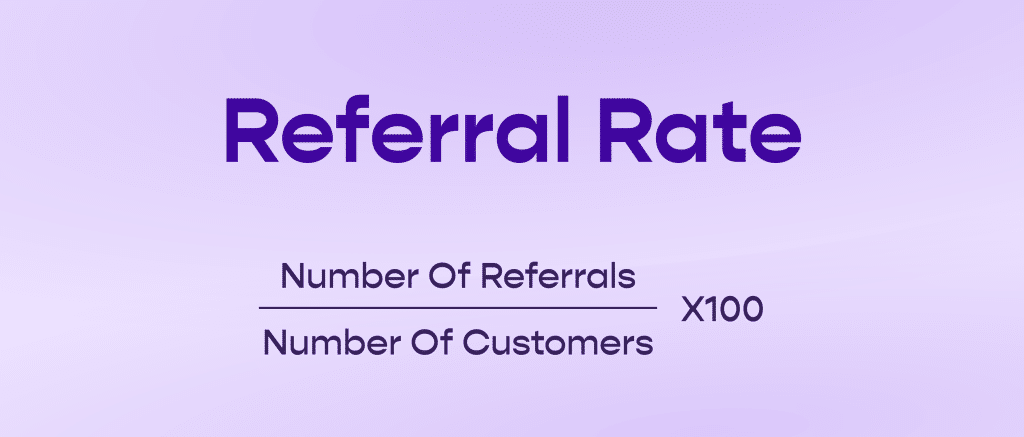
Important things to note when analyzing your referral rate:
- Monitor changes in referral rate over time.
- Analyze referral rates by customer segments (e.g., by product, region, or customer type) to identify which segments have the highest referral rate.
- Analyze where referrals are coming from (e.g., social media, word of mouth) to determine the most effective referral channels.
- Identify any obstacles preventing customers from referring your business and take steps to address them.
Referral hugely depends on how satisfied customers are with your products or services. Therefore, employing the same NPS and CSAT improvement strategies to boost Referral Rate will help your business create a referral culture among your customers.
-
Customer Effort Score (CES)
Customer Effort Score (CES) is a metric used to measure the ease of the customer experience, specifically how easy it is for customers to interact with your business to solve a problem or complete a task.
CES can be likened to the checkout process at a grocery store. Just as a customer wants a quick and hassle-free checkout process, they also want their interactions with a business to be easy and efficient.
Importance of Customer Effort Score as a Retention Metric
Here are some reasons why Customer Effort Score is a crucial customer retention metric:
- High CES leads to customer loyalty: Customers who have a positive experience with your business are more likely to become repeat customers and recommend your business to others. On the other hand, a low CES results in churn.
- Helps identify areas for improvement: By measuring CES, you can identify areas of your business that may be causing customer frustration or difficulty and make changes to improve the customer experience.
- Provides insights for product development: CES can provide valuable insights into how customers use your product or service and what changes could be made to make it more user-friendly.
- Helps reduce customer support costs: A high CES can help reduce the number of customer support requests and inquiries, as customers can find the information they need on their own easily.
How To Calculate Customer Effort Score
The formula for calculating Customer Effort Score is as follows:
CES = (Number of customers who rated their experience as “easy” or “very easy” / Total number of customers surveyed) x 100
Here are things to keep in mind when analyzing Customer Effort Score:
- Track changes in CES over time to identify trends and make improvements.
- Segment customers: Analyze CES by different customer segments (e.g., by product, region, or customer type) to identify which segments have the highest and lowest CES.
- Follow up with customers: Follow up with customers who rated their experience as challenging or very difficult to identify specific pain points and make improvements.
- Compare CES with other metrics: Analyze how CES correlates with other metrics such as customer satisfaction, net promoter score, and retention rate to understand the customer experience better.
-
Customer Loyalty Index (CLI)
Liverpool Football Club’s success at Anfield is not just due to the field’s design but, more importantly, the unwavering loyalty and deafening support of their fans, which intimidates opponents and boosts the team’s performance.
Similarly, the Customer Loyalty Index (CLI) measures customer loyalty by analyzing feedback, purchase history, and interactions.
A high CLI indicates strong customer satisfaction and advocacy, which, like Liverpool’s fan support, can significantly improve business performance and retention.
Importance of CLI as a Customer Retention Metric
Here are five reasons why Customer Loyalty Index is a vital retention metric:
- High CLI leads to customer retention: Customers with a high CLI are likelier to continue doing business with a brand and less likely to switch to a competitor.
- Provides a competitive advantage: Brands with high CLI can gain a competitive advantage over other brands, as loyal customers are more likely to recommend the brand to others.
- Increases customer lifetime value: Loyal customers are more likely to make repeat purchases and spend more money over time, increasing their lifetime value to the brand.
- Reduces customer acquisition costs: Brands with high CLI can reduce their acquisition costs as loyal customers are more likely to refer new customers to the brand.
- Helps identify areas for improvement: Measuring CLI can help brands identify areas where they can improve the customer experience, thereby increasing customer loyalty.
How to calculate Customer Loyalty Index
The formula for calculating Customer Loyalty Index can vary depending on the specific metrics used. It typically involves measuring customer loyalty based on factors such as repeat purchases, net promoter score, referral rate, customer satisfaction, and overall engagement with the brand.
Here are vital things to remember when analyzing Customer Loyalty Index:
- Use multiple metrics: To accurately measure CLI, use a combination of metrics that reflect customer loyalty, such as repeat purchases, referrals, and customer satisfaction.
- Use feedback to make improvements: Use customer feedback to identify areas where you can improve the customer experience and increase customer loyalty.
- Continuously monitor CLI: Monitor CLI over time to identify trends and adjust your retention strategies.
How to Improve Your Customer Loyalty Index
Interested in building a customer base as loyal to your business as Liverpool fans are to the club? Here are things you can do to improve your customer loyalty index
- Personalization: Offer personalized experiences to your customers by using their data to create targeted and relevant messaging, recommendations, and offers.
- Gamification: Gamification involves adding game-like elements to your customer engagement strategies, such as rewards programs, loyalty points, and challenges.
- Social responsibility: Incorporate social responsibility into your brand’s values and messaging. Customers are more likely to stay loyal to brands that align with their values and contribute positively to society.
- Customer feedback: Actively seek and incorporate customer feedback into your operations, products, and services. This shows that you value your customers’ opinions and are committed to improving their experiences.
- Surprise and delight: Surprise your customers with unexpected gestures that exceed their expectations, such as handwritten notes, personalized gifts, or special offers. These small acts of kindness can go a long way in building strong emotional connections and loyalty.
-
Active Customer Rate
Active customer rate is a retention metric that measures the percentage of customers who have purchased or taken a specific action within a given period.
Active Customer Rate measures customer retention, loyalty, and overall business performance. The period defined as “active” may vary depending on the industry, but it is typically a month, quarter, or year.
Importance of tracking Active Customer Rate as a Retention metric
- It indicates the health of a business: A high active customer rate shows that customers are engaged with the brand and are returning to make repeat purchases, which is essential for the growth of the business.
- It provides insights into customer behavior.
- Knowing the number of active customers and their buying patterns allows businesses to make accurate revenue projections and plan accordingly.
- Active customer rates can be used to segment customers based on their behavior, allowing businesses to personalize their marketing efforts and improve retention strategies.
- A declining active customer rate can indicate product, customer service, or marketing issues, allowing you to identify and address problems before they escalate.
How to Calculate Active Customer Rate
The formula for calculating active customer rate is given:
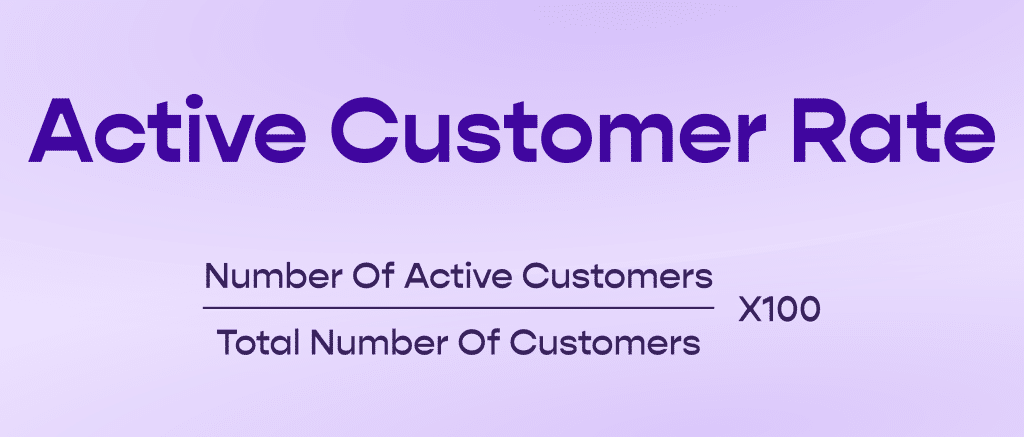
Things to note when analyzing active customer rates:
- Compare the active customer rate to previous periods to see if it is improving, declining, or staying the same.
- Analyze the active customer rate by customer segments to identify which groups have the highest and lowest rates.
- Look at the active customer rate with other retention metrics, such as customer lifetime value or churn rate.
- Consider external factors impacting the active customer rate, such as seasonality, industry trends, or economic conditions.
How to improve Active Customer Rate
- Offer a loyalty program or rewards to incentivize repeat purchases.
- Provide excellent customer service to ensure customers have a positive experience and feel valued.
- Use personalized marketing to target customers with relevant offers and promotions.
- Continuously improve the product or service to meet customer needs and exceed expectations.
- Communicate with customers through email newsletters or social media to stay top-of-mind and encourage repeat business.
-
Customer Acquisition Cost
Customer acquisition cost (CAC) refers to the cost you incur when acquiring a new customer. It is calculated by dividing the total cost of sales and marketing expenses by the number of new customers acquired during a specific period.
The CAC includes all expenses associated with marketing and sales, such as advertising costs, sales team salaries, commissions, promotions, and any other expenses directly related to acquiring new customers.
Why CAC is an Important Customer Retention Metric To Track
- CAC helps businesses understand the cost of acquiring new customers and the effectiveness of their marketing and sales strategies.
- CAC provides insight into how much money should be allocated toward customer acquisition.
- It provides a benchmark for comparing the cost of acquiring new customers across different marketing channels or campaigns.
- Identification of the most cost-effective customer acquisition channels, enabling businesses to optimize their marketing spend.
How to Calculate Customer Acquisition Cost
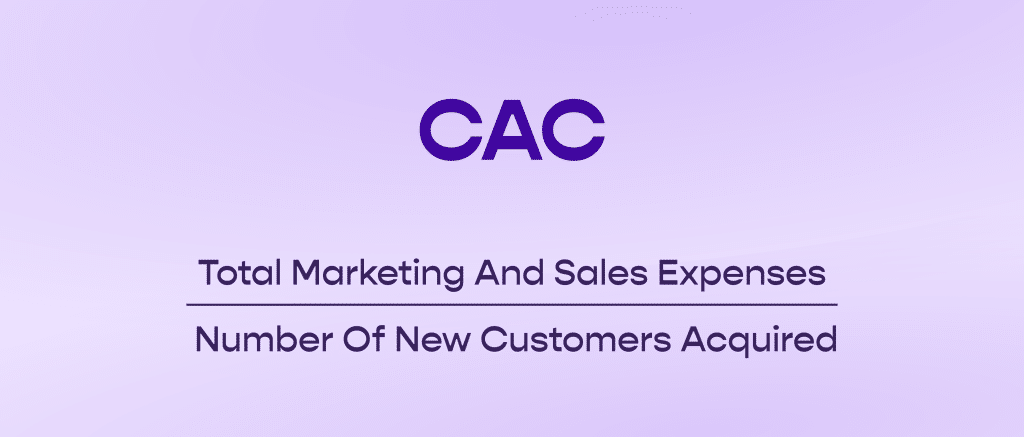
Here are things to remember when analyzing your customer acquisition costs:
- Compare the CAC to the customer lifetime value (CLTV) to determine if the cost of acquiring a new customer is justified by the revenue they are expected to generate.
- Analyze the CAC by customer segments to identify which groups have the highest and lowest acquisition costs.
- Consider external factors affecting the CAC, such as market saturation, industry trends, or economic conditions.
- Look at the CAC with other marketing and sales metrics, such as conversion rate or lead-to-customer ratio, to identify areas for improvement.
Strategies to help you lower customer acquisition costs
- Optimize marketing channels to reduce costs and increase the effectiveness of campaigns.
- Improve targeting to focus on the most profitable customer segments.
- Create and implement a referral program to encourage existing customers to refer new ones, thereby reducing acquisition costs.
- Implement lead nurturing campaigns to optimize conversion rates and reduce the number of leads that drop out of the sales funnel.
- Continuously monitor and analyze customer behavior to identify trends and make data-driven decisions that optimize customer acquisition efforts.
Over To You
You can track other customer retention metrics besides those discussed in this article. Measuring customer retention metrics is essential for any business looking to improve customer retention and drive long-term success.
Focusing on these key metrics allows you to retain existing customers and drive new customer acquisition through other vital metrics like CSAT, NPS, and Referral Rate. One interesting thing about some of these metrics is how connected they are, such that an improvement in a particular metric can yield positive results in another metric.
Customer Retention Metrics FAQs
What is the metric for customer retention?
The primary metric for customer retention is the Customer Retention Rate (CRR), which measures the percentage of customers a business retains over a specific period. It indicates how well a company keeps its existing customers engaged and satisfied.
What are the 8 C’s of customer retention?
The 8 C’s of customer retention refer to key principles that help build long-term relationships with customers:
- Commitment – Showing dedication to meeting customer needs.
- Consistency – Providing a reliable and predictable experience.
- Customization – Tailoring services or products to individual preferences.
- Communication – Maintaining clear, proactive communication with customers.
- Care – Demonstrating empathy and resolving issues promptly.
- Competence – Delivering high-quality products or services.
- Convenience – Ensuring a smooth and hassle-free customer experience.
- Community – Building a sense of belonging and connection around your brand.
What is the best way to calculate customer retention?
Customer retention is best calculated using the Customer Retention Rate (CRR) formula:
CRR = E − NS × 100
Where:
- E = Total customers at the end of a period
- N = New customers acquired during that period
- S = Total customers at the start of the period
This formula gives the percentage of customers retained, excluding new acquisitions.
What is a good customer retention ratio?
A good customer retention ratio varies by industry. Generally:
- Media and Professional Services see higher averages, around 84%, due to consistent audience engagement and trust-based client relationships.
- E-commerce, on the other hand, has a lower average retention rate of 30%, reflecting the competitive and dynamic nature of the online marketplace.
To determine whether your retention ratio is “good,” compare it to industry benchmarks and align it with your business goals

